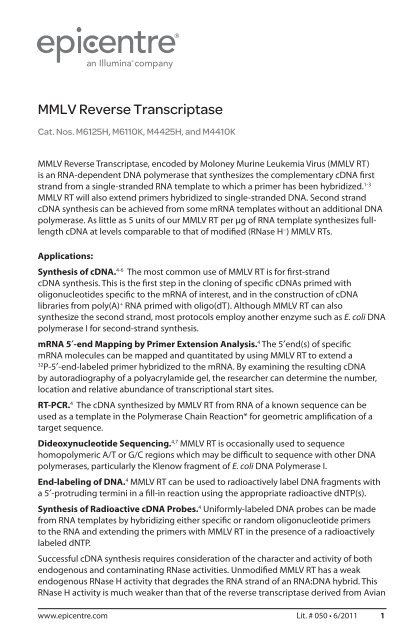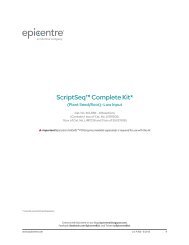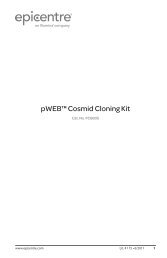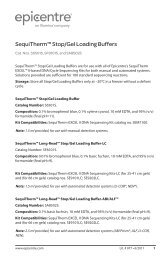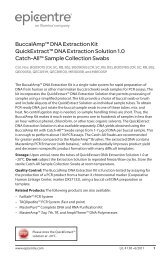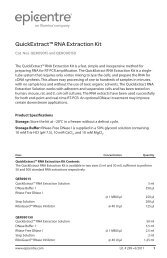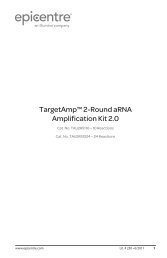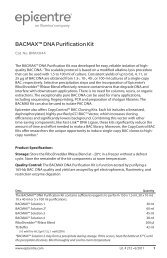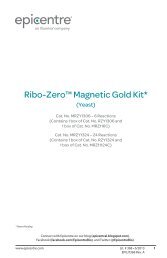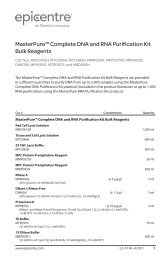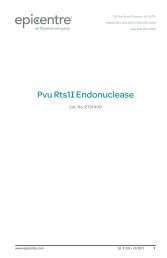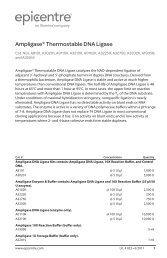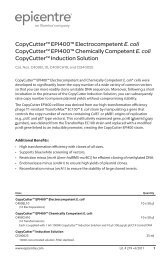Protocol for MMLV Reverse Transcriptase
Protocol for MMLV Reverse Transcriptase
Protocol for MMLV Reverse Transcriptase
Create successful ePaper yourself
Turn your PDF publications into a flip-book with our unique Google optimized e-Paper software.
<strong>MMLV</strong> <strong>Reverse</strong> <strong>Transcriptase</strong><br />
Cat. Nos. M6125H, M6110K, M4425H, and M4410K<br />
<strong>MMLV</strong> <strong>Reverse</strong> <strong>Transcriptase</strong>, encoded by Moloney Murine Leukemia Virus (<strong>MMLV</strong> RT)<br />
is an RNA-dependent DNA polymerase that synthesizes the complementary cDNA first<br />
strand from a single-stranded RNA template to which a primer has been hybridized. 1-3<br />
<strong>MMLV</strong> RT will also extend primers hybridized to single-stranded DNA. Second strand<br />
cDNA synthesis can be achieved from some mRNA templates without an additional DNA<br />
polymerase. As little as 5 units of our <strong>MMLV</strong> RT per μg of RNA template synthesizes fulllength<br />
cDNA at levels comparable to that of modified (RNase H − ) <strong>MMLV</strong> RTs.<br />
Applications:<br />
Synthesis of cDNA. 4-6 The most common use of <strong>MMLV</strong> RT is <strong>for</strong> first-strand<br />
cDNA synthesis. This is the first step in the cloning of specific cDNAs primed with<br />
oligonucleotides specific to the mRNA of interest, and in the construction of cDNA<br />
libraries from poly(A) + RNA primed with oligo(dT). Although <strong>MMLV</strong> RT can also<br />
synthesize the second strand, most protocols employ another enzyme such as E. coli DNA<br />
polymerase I <strong>for</strong> second-strand synthesis.<br />
mRNA 5′-end Mapping by Primer Extension Analysis. 4 The 5′end(s) of specific<br />
mRNA molecules can be mapped and quantitated by using <strong>MMLV</strong> RT to extend a<br />
32<br />
P-5′-end-labeled primer hybridized to the mRNA. By examining the resulting cDNA<br />
by autoradiography of a polyacrylamide gel, the researcher can determine the number,<br />
location and relative abundance of transcriptional start sites.<br />
RT-PCR. 4 The cDNA synthesized by <strong>MMLV</strong> RT from RNA of a known sequence can be<br />
used as a template in the Polymerase Chain Reaction* <strong>for</strong> geometric amplification of a<br />
target sequence.<br />
Dideoxynucleotide Sequencing. 4,7 <strong>MMLV</strong> RT is occasionally used to sequence<br />
homopolymeric A/T or G/C regions which may be difficult to sequence with other DNA<br />
polymerases, particularly the Klenow fragment of E. coli DNA Polymerase I.<br />
End-labeling of DNA. 4 <strong>MMLV</strong> RT can be used to radioactively label DNA fragments with<br />
a 5′-protruding termini in a fill-in reaction using the appropriate radioactive dNTP(s).<br />
Synthesis of Radioactive cDNA Probes. 4 Uni<strong>for</strong>mly-labeled DNA probes can be made<br />
from RNA templates by hybridizing either specific or random oligonucleotide primers<br />
to the RNA and extending the primers with <strong>MMLV</strong> RT in the presence of a radioactively<br />
labeled dNTP.<br />
Successful cDNA synthesis requires consideration of the character and activity of both<br />
endogenous and contaminating RNase activities. Unmodified <strong>MMLV</strong> RT has a weak<br />
endogenous RNase H activity that degrades the RNA strand of an RNA:DNA hybrid. This<br />
RNase H activity is much weaker than that of the reverse transcriptase derived from Avian<br />
www.epicentre.com Lit. # 050 • 6/2011 1
<strong>MMLV</strong> <strong>Reverse</strong> <strong>Transcriptase</strong><br />
Myeloblastosis Virus (AMV). The high level of RNase H associated with AMV RT limits the<br />
length and total yield of cDNA that can be made with the avian enzyme, making <strong>MMLV</strong><br />
RT the preferred enzyme <strong>for</strong> most applications. <strong>MMLV</strong> RT does not have endogenous<br />
DNA exonuclease activity. Our preparation of <strong>MMLV</strong> RT is free of exogenous RNase, a<br />
common contaminant in commercial preparations of reverse transcriptase.<br />
Product Specifications<br />
Storage: Store only at –20°C in a freezer without a defrost cycle.<br />
Storage Buffer: <strong>MMLV</strong> RT is supplied in a 50% glycerol solution containing 50 mM<br />
Tris-HCl (pH 7.5), 100 mM NaCl, 1.0 mM dithiothreitol (DTT), 0.1 mM EDTA, and<br />
0.1% Triton® X-100.<br />
Unit Definition: One unit of <strong>MMLV</strong> RT catalyzes the incorporation of 1 nmol of dTTP into<br />
acid-insoluble material in 10 minutes at 37°C using oligo(dT) 12-18<br />
-primed poly(A) n<br />
as a<br />
template.<br />
Note: The unit assay conditions are considerably different from the recommended reaction<br />
conditions described below.<br />
Activity Assay: The unit definition assay is per<strong>for</strong>med in a reaction containing 50 mM<br />
Tris-HCl (pH 8.6), 40 mM KCl, 1 mM MnSO 4<br />
, 1 mM DTT, 200 mM poly(A):oligo-(dT) 12-18<br />
(1:1 molar ratio), and 0.5 mM dTTP.<br />
10X Reaction Buffer: 0.5 M Tris-HCl (pH 8.3), 0.1 M MgCl 2<br />
, and 0.75 M KCl.<br />
Contaminating Activity Assays: <strong>MMLV</strong> RT is free of detectable RNase and DNase<br />
(exo- and endonuclease) activities.<br />
Related Products: The following products are also available:<br />
– dNTP Solutions<br />
– MasterAmp RT-PCR Kits <strong>for</strong> High Sensitivity<br />
– MasterAmp High Fidelity RT-PCR Kits<br />
– MasterPure RNA Purification Kits<br />
– MasterAmp Tth DNA Polymerase<br />
Recommended Reaction Conditions<br />
For first-strand cDNA synthesis, we recommend using 5-25 units of <strong>MMLV</strong> RT per<br />
microgram of RNA template. For best results, run a pilot reaction as described by<br />
Sambrook et al. 4 Dilutions of the <strong>MMLV</strong> RT stock can be made up in 1X <strong>MMLV</strong> RT Buffer<br />
supplemented with 10 mM DTT. Dilutions should be made just prior to use and kept on<br />
ice.<br />
2 www.epicentre.com
<strong>MMLV</strong> <strong>Reverse</strong> <strong>Transcriptase</strong><br />
First-strand cDNA Synthesis<br />
1. Add the following reagents to a microcentrifuge tube at room temperature; add the<br />
<strong>MMLV</strong> RT last.<br />
x μl RNase-free water<br />
5 μl 10X <strong>MMLV</strong> RT Buffer<br />
5 μl 0.1 M DTT<br />
10 μl dNTP Mix (2.5 mM each dNTP)<br />
0.5 μg oligo(dT) 12-18<br />
1 μg poly-A + selected mRNA<br />
5-25 U <strong>MMLV</strong> RT<br />
50 μl Total reaction volume<br />
2. Incubate at 37°C <strong>for</strong> 60 minutes.<br />
Actinomycin D can be used to inhibit synthesis of the second cDNA strand by <strong>MMLV</strong> RT. 3,4<br />
If used, actinomycin D should be added to final concentration of 50 μg/ml.<br />
Warning: Actinomycin D is a teratogen and a carcinogen.<br />
References:<br />
1. Gerard, G.F. and Grandgenett, D.P. (1975) J. Virology 15, 785.<br />
2. Roth, M.J. et al., (1985) J. Biol. Chem. 260, 9326.<br />
3. Gerard, G.F. and D’Alessio, J.M. (1993) in Meth. in Mol. Biol., vol. 16, Burrell and Totowa<br />
(eds.), NJ: Humana Press.<br />
4. Sambrook, J. et al., (1989) Molecular Cloning: A Laboratory Manual (2nd ed.) New York:<br />
Cold Spring Harbor Laboratory Press.<br />
5. Okayama, H. et al., (1987) Meth. Enzymology 154, 3.<br />
6. Heidecker, G. and Messing, J. (1987) Meth. Enzymology 154, 28.<br />
7. Chen, E.Y. and Seeburg, P.H. (1985) DNA 4, 165.<br />
*The Polymerase Chain Reaction is covered by patents owned by Hoffman-LaRoche, Inc., Nutley, New Jersey.<br />
MasterAmp, and MasterPure are trademarks of Epicentre, Madison, Wisconsin.<br />
Triton is a registered trademark of Rohm & Haas Philadelphia, Pennsylvania.<br />
Visit our technical blog: epicentral.blogspot.com<br />
techhelp@epicentre.com • (800) 284-8474 3
726 Post Road, Madison, WI 53713 (800) 284-8474 (608) 258-3080 Fax (608) 258-3088<br />
4 www.epicentre.com


